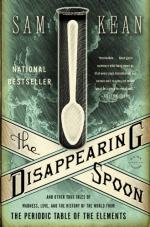|
This section contains 951 words (approx. 3 pages at 400 words per page) |

|
Summary
Chapter 4: Many elements are formed when stars heat themselves by fusing hydrogen together to form helium. When stars run out of hydrogen, they begin to burn and fuse helium, which creates other elements. As stars continue to age and burn through elements, they continue to create new ones, producing everything up to iron. The rest of the natural elements, twenty-seven through ninety-two, are created when a star dies and becomes a supernova. This is also how our solar system was created. By analyzing the amount and distribution of elements across Earth, scientists can determine the age of our planet and how it was formed. Iron, uranium, and lead were essential elements in this deductive process.
The distribution and placement of elements in the Earth's crust can also tell us about our planet's history. For example, the presence of iridium, which is...
(read more from the Part II: Chapters 4-5 Summary)
|
This section contains 951 words (approx. 3 pages at 400 words per page) |

|




